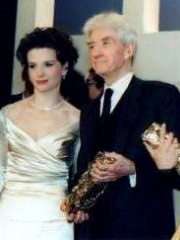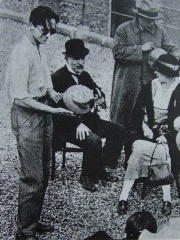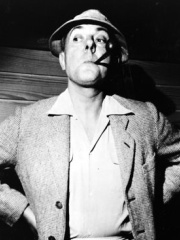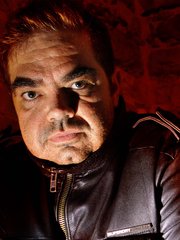







The Most Famous
FILM DIRECTORS from France
This page contains a list of the greatest French Film Directors. The pantheon dataset contains 2,041 Film Directors, 192 of which were born in France. This makes France the birth place of the 2nd most number of Film Directors.
Top 10
The following people are considered by Pantheon to be the top 10 most legendary French Film Directors of all time. This list of famous French Film Directors is sorted by HPI (Historical Popularity Index), a metric that aggregates information on a biography's online popularity. Visit the rankings page to view the entire list of French Film Directors.

1. Roman Polanski (b. 1933)
With an HPI of 79.81, Roman Polanski is the most famous French Film Director. His biography has been translated into 92 different languages on wikipedia.
Raymond Roman Thierry Polański (né Liebling; born 18 August 1933) is a Polish and French filmmaker and actor. He is the recipient of numerous accolades, including an Academy Award, three British Academy Film Awards, ten César Awards, two Golden Globe Awards, as well as the Golden Bear and a Palme d'Or. In 1977, Polanski was arrested for drugging and raping a 13-year-old girl. He pleaded guilty to the lesser charge of unlawful sex with a minor in exchange for a probation-only sentence. The night before his sentencing hearing in 1978, he learned that the judge would likely reject the proffered plea bargain, so he fled the U.S. to Europe, where he continued his career. He remains a fugitive from the U.S. justice system. Subsequently, allegations of abuse have been made by several women. Polanski's parents moved the family from his birthplace in Paris back to Kraków in 1937. Two years later, the invasion of Poland by Nazi Germany started World War II, and the family found themselves trapped in the Kraków Ghetto. After his mother and father were taken in raids, Polanski spent his formative years in foster homes, surviving the Holocaust by adopting a false identity and concealing his half Jewish heritage. In 1969, Polanski's pregnant wife, actress Sharon Tate, was murdered, along with four friends by members of the Manson Family in an internationally notorious case. Polanski's first feature-length film, Knife in the Water (1962), made in Poland, was nominated for the United States Academy Award for Best Foreign Language Film. A few years later he first left for France and then moved to the United Kingdom, where he directed his first three English-language feature-length films: Repulsion (1965), Cul-de-sac (1966), and The Fearless Vampire Killers (1967). In 1968, he settled in the United States and cemented his status in the film industry by directing the horror film Rosemary's Baby (1968). He made Macbeth (1971) in England and Chinatown (1974) back in Hollywood. His other critically acclaimed films include The Tenant (1976), Tess (1979), Death and the Maiden (1994), The Pianist (2002) which won him the Academy Award for Best Director, The Ghost Writer (2010), Venus in Fur (2013), and An Officer and a Spy (2019). Polanski has made 23 feature films to date. He has also starred in several Polish films as well as in his own films.

2. François Truffaut (1932 - 1984)
With an HPI of 77.56, François Truffaut is the 2nd most famous French Film Director. His biography has been translated into 80 different languages.
François Roland Truffaut (UK: TROO-foh, TRUU-, US: troo-FOH; French: [fʁɑ̃swa ʁɔlɑ̃ tʁyfo]; 6 February 1932 – 21 October 1984) was a French filmmaker, actor, and critic. He is widely regarded as one of the founders of the French New Wave. He came under the tutelage of film critic Andre Bazin as a young man and was hired to write for Bazin's Cahiers du Cinéma, where he became a proponent of the auteur theory, which posits that a film's director is its true author. The 400 Blows (1959), starring Jean-Pierre Léaud as Truffaut's alter-ego Antoine Doinel, was a defining film of the New Wave. Truffaut supplied the story for another milestone of the movement, Breathless (1960), directed by his Cahiers colleague Jean-Luc Godard. His other notable films include Shoot the Piano Player (1960), Jules and Jim (1962), The Soft Skin (1964), Two English Girls (1971) and The Last Metro (1980). Truffaut's Day for Night (1973) earned him the BAFTA Award for Best Film and the Academy Award for Best Foreign Language Film. He played the doctor in The Wild Child (1970), the director of the film-within-the-film in Day For Night and the scientist in Steven Spielberg's Close Encounters of the Third Kind (1977). He starred in The Green Room (1978), based on Henry James's "The Altar of the Dead". He wrote Hitchcock/Truffaut (1966), a book-length interview with his hero Alfred Hitchcock which tied for second on Sight and Sound's list of the greatest books on film. Truffaut paid homage to Hitchcock in The Bride Wore Black (1968), Mississippi Mermaid (1969) and his last film, Confidentially Yours (1983). He was married from 1957 until 1964 to Madeleine Morgenstern, in 1968 became engaged to leading actress Claude Jade from three of his films, and lived together with Fanny Ardant, actress in his two last films, until his death. David Thomson writes that "for many people who love film Truffaut will always seem like the most accessible and engaging crest of the New Wave."

3. Jean-Luc Godard (1930 - 2022)
With an HPI of 77.02, Jean-Luc Godard is the 3rd most famous French Film Director. His biography has been translated into 75 different languages.
Jean-Luc Godard (UK: GOD-ar, US: goh-DAR; French: [ʒɑ̃ lyk ɡɔdaʁ]; 3 December 1930 – 13 September 2022) was a French and Swiss film director, screenwriter, and film critic. He rose to prominence as a pioneer of the French New Wave film movement of the 1960s, alongside such filmmakers as François Truffaut, Agnès Varda, Éric Rohmer and Jacques Demy. He was arguably the most influential French filmmaker of the post-war era. According to AllMovie, his work "revolutionized the motion picture form" through its experimentation with narrative, continuity, sound, and camerawork. During his early career as a film critic for Cahiers du Cinéma, Godard criticized mainstream French cinema's "Tradition of Quality" and championed Hollywood directors like Alfred Hitchcock and Howard Hawks. In response, he and like-minded critics began to make their own films, challenging the conventions of traditional Hollywood in addition to French cinema. Godard first received global acclaim for Breathless (1960), a milestone in the New Wave movement. His work makes use of frequent homages and references to film history, and often expressed his political views; he was an avid reader of existentialism and Marxist philosophy, and in 1969 formed the Dziga Vertov Group with other radical filmmakers to promote political works. After the New Wave, his politics were less radical, and his later films came to be about human conflict and artistic representation "from a humanist rather than Marxist perspective." He explained that "As a critic, I thought of myself as a film-maker. Today I still think of myself as a critic, and in a sense I am, more than ever before. Instead of writing criticism, I make a film, but the critical dimension is subsumed." Godard was married three times, to actresses Anna Karina and Anne Wiazemsky, both of whom starred in several of his films, and later to his longtime partner Anne-Marie Miéville. His collaborations with Karina in Vivre sa vie (1962), Bande à part (1964) and Pierrot le Fou (1965) were called "arguably the most influential body of work in the history of cinema" by Filmmaker magazine. In a 2002 Sight & Sound poll, Godard ranked third in the critics' top ten directors of all time. He is said to have "generated one of the largest bodies of critical analysis of any filmmaker since the mid-twentieth century." His work has been central to narrative theory and has "challenged both commercial narrative cinema norms and film criticism's vocabulary." In 2010, Godard was awarded an Academy Honorary Award. He was known for his aphorisms, such as "All you need to make a movie is a girl and a gun" and "A film consists of a beginning, a middle and an end, though not necessarily in that order." Some critics have claimed that Godard's films contain prevailing themes of misogyny and sexism towards women. Feminist film theorist Laura Mulvey, has agreed that "While trying to decode a deep-seated, but interesting, misogyny, I came to think that Godard's cinema knows its own entrapment...for feminist curiosity, it is still a goldmine."

4. Georges Méliès (1861 - 1938)
With an HPI of 76.83, Georges Méliès is the 4th most famous French Film Director. His biography has been translated into 74 different languages.
Marie-Georges-Jean Méliès ( mayl-YES, French: [maʁi ʒɔʁʒ ʒɑ̃ meljɛs]; 8 December 1861 – 21 January 1938) was a French filmmaker, actor, magician, and toymaker. He led many technical and narrative developments in the early days of cinema, primarily in the fantasy and science fiction genres. Méliès rose to prominence creating "trick films" and became well known for his innovative use of special effects, popularizing such techniques as substitution splices, multiple exposures, time-lapse photography, dissolves, and hand-painted colour. He was also one of the first filmmakers to use storyboards in his work. His most important films include A Trip to the Moon (1902) and The Impossible Voyage (1904).

5. Roger Vadim (1928 - 2000)
With an HPI of 73.96, Roger Vadim is the 5th most famous French Film Director. His biography has been translated into 49 different languages.
Roger Vadim Plemiannikov (French: [ʁɔʒe vadim]; 26 January 1928 – 11 February 2000) was a French screenwriter, film director, and producer, as well as an author, artist, and occasional actor. His best-known works are visually lavish films with erotic qualities, such as And God Created Woman (1956), Blood and Roses (1960), The Game Is Over (1966), Barbarella (1968), and Pretty Maids All in a Row (1971).

6. Jean-Jacques Annaud (b. 1943)
With an HPI of 73.14, Jean-Jacques Annaud is the 6th most famous French Film Director. His biography has been translated into 53 different languages.
Jean-Jacques Annaud (French: [ʒɑ̃ ʒak ano]; born 1 October 1943) is a French film director, screenwriter and producer. He directed Quest for Fire (1981), The Name of the Rose (1986), The Bear (1988), The Lover (1992), Seven Years in Tibet (1997), Enemy at the Gates (2001), Black Gold (2011), and Wolf Totem (2015). Annaud has received numerous awards for his work, including five César Awards, one David di Donatello Award, and one National Academy of Cinema Award. Annaud's first film, Black and White in Color (1976), received an Academy Award for Best Foreign Language Film. His most recent film is Notre-Dame on Fire, released in 2022.

7. Éric Rohmer (1920 - 2010)
With an HPI of 72.81, Éric Rohmer is the 7th most famous French Film Director. His biography has been translated into 52 different languages.
Jean Marie Maurice Schérer or Maurice Henri Joseph Schérer, known as Éric Rohmer (French: [eʁik ʁomɛʁ]; 21 March 1920 – 11 January 2010), was a French film director, film critic, journalist, novelist, screenwriter, and teacher. Rohmer was the last of the post-World War II French New Wave directors to become established. He edited the influential film journal Cahiers du cinéma from 1957 to 1963, while most of his colleagues—among them Jean-Luc Godard and François Truffaut—were making the transition from critics to filmmakers and gaining international attention. Rohmer gained international acclaim around 1969 when his film My Night at Maud's was nominated at the Academy Awards. He won the San Sebastián International Film Festival with Claire's Knee in 1971 and the Golden Lion at the Venice Film Festival for The Green Ray in 1986. In 2001, Rohmer received the Venice Film Festival's Career Golden Lion. After his death in 2010, his obituary in The Daily Telegraph called him "the most durable filmmaker of the French New Wave", outlasting his peers and "still making movies the public wanted to see" late in his career.

8. William Wyler (1902 - 1981)
With an HPI of 72.61, William Wyler is the 8th most famous French Film Director. His biography has been translated into 68 different languages.
William Wyler (; born Willi Wyler (German: [ˈvɪli ˈvi:lɐ]); July 1, 1902 – July 27, 1981) was a German-born American film director and producer. Known for his work in numerous genres over five decades, he received numerous awards and accolades, including three Academy Awards. He holds the record of twelve nominations for the Academy Award for Best Director. For his oeuvre of work, Wyler was awarded the Irving G. Thalberg Memorial Award, the Directors Guild of America Lifetime Achievement Award, and the American Film Institute Life Achievement Award. Wyler emigrated to the United States in 1921 where he worked first for Universal Studios in New York before moving to Los Angeles. By 1925, he was the youngest director at Universal, and in 1929 he directed Hell's Heroes, Universal's first sound production filmed entirely on location. Wyler went on to win the Academy Award for Best Director three times, for Mrs. Miniver (1942), The Best Years of Our Lives (1946), and Ben-Hur (1959), all of which also won for Best Picture. He was Oscar-nominated for Dodsworth (1936), Wuthering Heights (1939), The Letter (1940), The Little Foxes (1941), The Heiress (1949), Detective Story (1952), Roman Holiday (1953), Friendly Persuasion (1956), and The Collector (1965). Film historian Ian Freer calls Wyler a "bona fide perfectionist", whose penchant for retakes and an attempt to hone every last nuance "became the stuff of legend." His ability to direct a string of classic literary adaptations into huge box-office and critical successes made him one of "Hollywood's most bankable moviemakers" from the 1930s to the 1960s. Through his talent for staging, editing, and camera movement, he turned dynamic theatrical spaces into cinematic ones. Wyler is also known for his work as an actors' director, often propelling them to stardom.

9. Claude Chabrol (1930 - 2010)
With an HPI of 72.57, Claude Chabrol is the 9th most famous French Film Director. His biography has been translated into 55 different languages.
Claude Henri Jean Chabrol (French: [klod ʃabʁɔl]; 24 June 1930 – 12 September 2010) was a French film director and a member of the French New Wave (nouvelle vague) group of filmmakers who first came to prominence at the end of the 1950s. Like his colleagues and contemporaries Jean-Luc Godard, François Truffaut, Éric Rohmer and Jacques Rivette, Chabrol was a critic for the influential film magazine Cahiers du Cinéma before beginning his career as a film maker. Chabrol's career began with Le Beau Serge (1958), inspired by Hitchcock's Shadow of a Doubt (1943). Thrillers became something of a trademark for Chabrol, with an approach characterized by a distanced objectivity. This is especially apparent in Les Biches (1968), La Femme infidèle (1969), and Le Boucher (1970) – all featuring Stéphane Audran, who was his wife at the time. Sometimes characterized as a "mainstream" New Wave director, Chabrol remained prolific and popular throughout his half-century career. In 1978, he cast Isabelle Huppert as the lead in Violette Nozière. On the strength of that effort, the pair went on to others including the successful Madame Bovary (1991) and La Cérémonie (1995). Film critic John Russell Taylor has stated that "there are few directors whose films are more difficult to explain or evoke on paper, if only because so much of the overall effect turns on Chabrol's sheer hedonistic relish for the medium...Some of his films become almost private jokes, made to amuse himself." James Monaco has called Chabrol "the craftsman par excellence of the New Wave, and his variations upon a theme give us an understanding of the explicitness and precision of the language of the film that we don't get from the more varied experiments in genre of Truffaut or Godard."

10. Luc Besson (b. 1959)
With an HPI of 72.41, Luc Besson is the 10th most famous French Film Director. His biography has been translated into 67 different languages.
Luc Paul Maurice Besson (French: [lyk bɛsɔ̃]; born 18 March 1959) is a French filmmaker. He directed and produced the films Subway (1985), The Big Blue (1988), and La Femme Nikita (1990). Associated with the Cinéma du look film movement, he has been nominated for a César Award for Best Director and Best Picture for his films Léon: The Professional (1994) and The Messenger: The Story of Joan of Arc (1999). He won Best Director and Best French Director for his sci-fi action film The Fifth Element (1997). He wrote and directed the sci-fi action film Lucy (2014), the space opera film Valerian and the City of a Thousand Planets (2017), and the fantasy romantic movie Dracula: A Love Tale (2025). In 1980, near the beginning of his career, he founded his own production company, Les Films du Loup, later renamed Les Films du Dauphin. It was superseded in 2000 when he co-founded EuropaCorp with longtime collaborator Pierre-Ange Le Pogam. As writer, director, or producer, Besson has been involved in the creation of more than 50 films.
People
Pantheon has 192 people classified as French film directors born between 1860 and 1983. Of these 192, 88 (45.83%) of them are still alive today. The most famous living French film directors include Roman Polanski, Jean-Jacques Annaud, and Luc Besson. The most famous deceased French film directors include François Truffaut, Jean-Luc Godard, and Georges Méliès. As of April 2024, 13 new French film directors have been added to Pantheon including Coralie Fargeat, Stéphane Sednaoui, and Nabil Ayouch.
Living French Film Directors
Go to all RankingsRoman Polanski
1933 - Present
HPI: 79.81
Jean-Jacques Annaud
1943 - Present
HPI: 73.14
Luc Besson
1959 - Present
HPI: 72.41
Jacques Audiard
1952 - Present
HPI: 70.81
Claude Lelouch
1937 - Present
HPI: 69.72
Jean-Pierre Jeunet
1953 - Present
HPI: 68.66
Frank Darabont
1959 - Present
HPI: 65.03
François Ozon
1967 - Present
HPI: 64.57
Francis Veber
1937 - Present
HPI: 64.00
Leos Carax
1960 - Present
HPI: 63.68
Nadine Trintignant
1934 - Present
HPI: 63.48
Jacques Doillon
1944 - Present
HPI: 63.45
Deceased French Film Directors
Go to all RankingsFrançois Truffaut
1932 - 1984
HPI: 77.56
Jean-Luc Godard
1930 - 2022
HPI: 77.02
Georges Méliès
1861 - 1938
HPI: 76.83
Roger Vadim
1928 - 2000
HPI: 73.96
Éric Rohmer
1920 - 2010
HPI: 72.81
William Wyler
1902 - 1981
HPI: 72.61
Claude Chabrol
1930 - 2010
HPI: 72.57
Alain Resnais
1922 - 2014
HPI: 72.02
Robert Bresson
1901 - 1999
HPI: 71.80
René Clair
1898 - 1981
HPI: 70.96
Jacques Tati
1907 - 1982
HPI: 70.76
René Clément
1913 - 1996
HPI: 69.71
Newly Added French Film Directors (2025)
Go to all RankingsCoralie Fargeat
1976 - Present
HPI: 56.33
Stéphane Sednaoui
1963 - Present
HPI: 52.34
Nabil Ayouch
1969 - Present
HPI: 51.01
Christian Carion
1963 - Present
HPI: 48.54
Benoît Delhomme
1961 - Present
HPI: 47.23
Xavier Gens
1975 - Present
HPI: 46.58
Philippe de Chauveron
1965 - Present
HPI: 46.40
Alice Winocour
1976 - Present
HPI: 45.85
Vincent Paronnaud
1970 - Present
HPI: 45.38
Audrey Diwan
HPI: 44.35
Sébastien Lifshitz
1968 - Present
HPI: 43.88
Mati Diop
1982 - Present
HPI: 43.17
Overlapping Lives
Which Film Directors were alive at the same time? This visualization shows the lifespans of the 25 most globally memorable Film Directors since 1700.



























